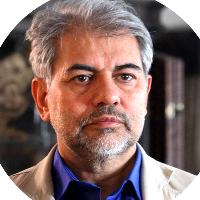The Nature of Iranian Visual Culture Represented Graphically
Author(s):
Abstract:
Today, the dominance of modern media is growing thanks to various soft wares, graphic patterns and fonts. Although it has created a visually universal language to ease communication, it has also marginalized certain visual cultures around the globe. Such threats in Iran have appeared in the form of damaged views of cities and monumental patterns replaced with unfamiliar elements. In order find solutions to such concerns, every now and then, issues like Iranian identity, applications of Iranian pictures, and Iranian domestic content have come to the fore. The present study aimed to reach a comprehensive approach to deal with the problems mentioned and with how to represent domestic visual culture effectively. In fact, it aimed to revitalize national archetypes and to represent them in a new way based on modern graphic principles. The questions of the research include: what is the Iranian visual culture? What is meant by representation of Iranian visual identity graphically? The result indicated that Iranian visual identity is the visual similarity of a work to other Iranian works so that it is distinguished from the works of other nations. Iranian visual identity is divided into general and corporate identities. Iranian visual identity is inspired by representation and recreation of Iranian pictures and motifs. Visual corporate identity include formally approved symbols, and flags which generally follow certain norms and principles. Graphic representation of Iranian visual culture implies a given degree of similarity to Iranian visual culture so that the quality of being Iranian can be readily recognized. The present study is an applied qualitative research. Data were gathered based on library sources and media databases.
Language:
English
Published:
Bagh-e Nazar, Volume:13 Issue: 40, 2016
Pages:
35 to 44
https://magiran.com/p1561726
سامانه نویسندگان
مقالات دیگری از این نویسنده (گان)
-
A Comparative Study of Horse Images in Iranian Paintings (Ilkhānid Period) and Chinese Art (Song and Yuan Periods)
Bahareh Moayeri *, , Syyed Abutorab Ahmadpanah
Negareh journal, -
The Romantic Gaze: The Romantic Gaze: the phenomenon of the visual in the Majnun and Leyla Painting of Jami’s Haft Awrang, the Mashhad School in Comparison with Poetic Narratives of Jami and Attar
Monireh Panjtani *,
Journal of Mysticism Studies in Literature,



